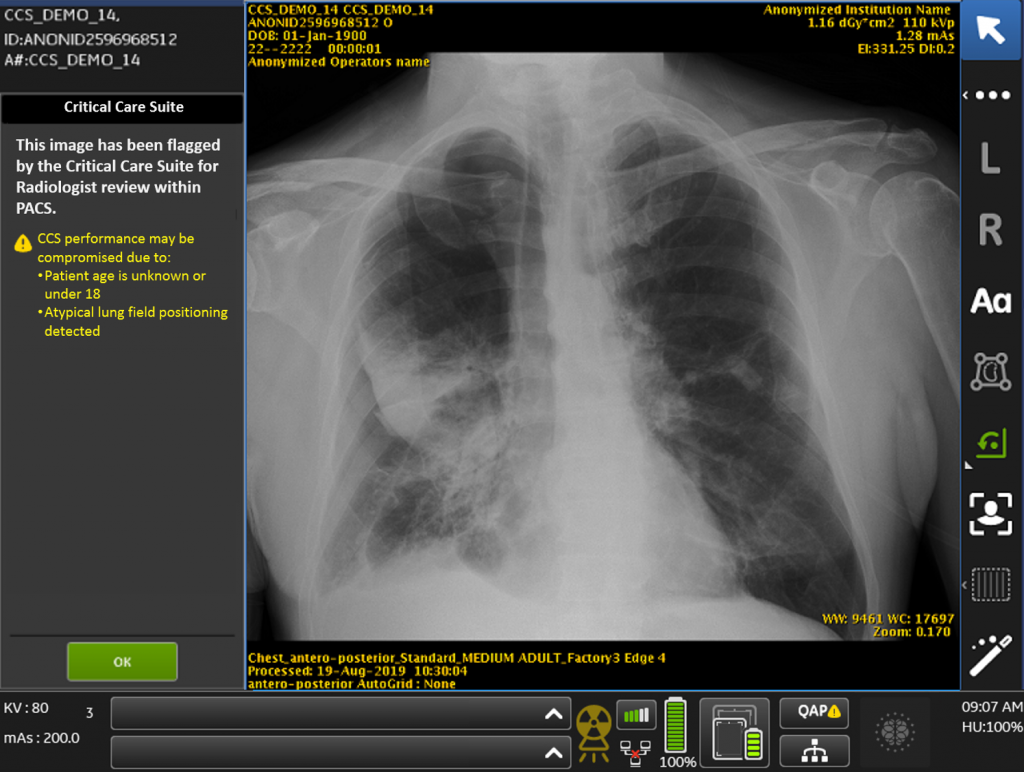
September 17, 2019

BREATHING EASIER
A collapsed lung can feel like being trapped underwater and struggling to breathe. Pneumothorax — as doctors call the condition — affects some 74,000 Americans every year. It can be detected by an X-ray and it is easily treatable, if caught early. But similar symptoms could also point to pneumonia, a heart issue or even a panic attack. “The timing of the diagnosis is important,” says Dr. Rachael Callcut, a surgeon at University of California San Francisco's Zuckerberg San Francisco General Hospital and Trauma Center and director of data science for the Center for Digital Health Innovation. “The longer we go without knowing, the higher the risk to the patient.
The smart solution: Callcut said this uncertainty made pneumothorax the perfect test case for artificial intelligence (AI) that can read X-rays. Working with GE Healthcare, she helped develop the Critical Care Suite, a collection of algorithms embedded in a mobile X-ray device. Last week, the FDA cleared the AI for use. This means doctors can begin working with the software in pilot tests. The software should start to show up more widely in hospitals early next year. Says Katelyn Nye, general manager of mobile radiology and AI at GE Healthcare: “We just passed a significant milestone which will begin to help technologists and radiologists do their jobs more efficiently.”
Learn more here.
FRESH AIR
The ancient Turkish city of Bergama is full of sites reflecting thousands of years of rich history, not to mention throngs of tourists who come there each year. But with few career options beyond the tourist trade, many of Bergama’s young people move elsewhere. In his youth, Bora Hodo, a Bergama native, followed the path of most of his peers, taking a part-time job as a tour guide and then leaving town for college. His career has led him to Istanbul, where he started working as an engineer at LM Wind Power, a unit of GE Renewable Energy.
Winds of change: When LM Wind Power opened a wind turbine blade manufacturing facility here in 2017, Hodo grabbed the chance to return to his hometown. Working out of a local hotel, Hodo recruited others to join him. It was a smart move. The factory produced its 500th wind turbine blade last month and in the spring, LM Wind Power broke ground on a $30 million expansion of the facility. That project will add another 300 employees to its 480-person staff and additional post-blade molding capabilities.
Learn more here.
BUILDING BLOCKS OF THE FUTURE
In 2016, the Bureau of Labor Statistics predicted that in the next 10 years, jobs related to science, technology, engineering and math, or STEM, will increase faster than other occupations. Those employees will earn a median annual wage of nearly $85,000, more than twice as much as their non-STEM counterparts. It’s no wonder that some parents are eager to expose their children, and daughters especially, to as many STEM activities as possible. That’s because women hold fewer than 30% of professional science and engineering jobs. But how do you get kids stoked about math, manufacturing and metal fabrication?
Picking up STEM: A host of forward-thinking educators are sparking the interest of K-12 students through various programs. These include launching a 3D-printing club for girls where they may have the opportunity to design a prosthetic body part for a classmate; recruiting players from the Boston Celtics to show how digital technology is revolutionizing basketball; training Ohio teens in robotic welding for potential job placement at GE Aviation; and holding competitions where tens of thousands of students from more than 70 countries gather to design fearsome robots capable of medieval-like battles. GE and its employees have been backing some of these programs.
Find out more here.
COOLEST THINGS ON EARTH ?
1. Vision Quest
Doctors in England used stem cells to restore sight to a man who was blinded in one eye during an ammonia attack more than two decades ago.
2. Dark Matter
MIT scientists developed the “blackest material to date” and used it to cloak a $2 million 16-carat yellow diamond and hide it from view.
3. Heart Smart
Researchers at the University of Surrey in England developed a type of AI that can spot congestive heart failure with 100% accuracy by analyzing just one heartbeat.
Read more about this week’s Coolest Things on Earth here.
— QUOTE OF THE DAY —
“X-ray — the world’s oldest form of medical imaging — just got a whole lot smarter, and soon, the rest of our offerings will too.”
— Kieran Murphy, president and CEO of GE Healthcare
Quote: GE Reports. Image: GE Healthcare.
ENJOY THIS NEWSLETTER?
Please send it to your friends and let them know they can subscribe here.




